Backyard Homestead Hay Growing Tips and Tools
Rising feed costs have spurred us to start harvesting our lawn! We know that it is not the same as high quality timothy or alfalfa. We are simply allowing our lawn to grow into a pasture by mowing once every 4-5 weeks, instead of every weekend. The grass grows about 6-10 inches tall in 4 weeks and that’s as much as the mower deck on our homestead tractor can handle. One important note is that we have NEVER used any chemicals on our grass.
Here are our suggested steps, if you would also like to save money on feed costs by harvesting your lawn.

Step #1: Know your lawn
Which grasses and weeds make up your lawn?
Our lawn is half grass and half “green carpet” (aka weeds). We have masses of violets, white clover, plantain, pigweed, lamb’s quarters, amaranth and smartweed. Mixed in with that is a fair amount of fescue and bermuda grasses. All of those are safe and nutritious for our livestock. There are of course a few unpalatable weeds that we try to avoid feeding our animals such as pokeweed and black nightshade.
Our rabbits will still receive their ration of pellets every other day in addition to the dried greens. In the summer months we are feeding them fresh greens harvested while weeding the garden and yard.
Our ducks particularly enjoy eating smartweed, which is our most abundant weed. We are raising our summer chicks on pasture. They are learning to appreciate greens and bugs as well as their chicken mash.
How long have you known your grass?
We have lived here a little over 6 years. I know that no chemicals have been used on our lawn during those years. Therefore, it has been at least 6 years since anything could have been sprayed on our lawn by the previous owners. If you moved to your property more recently than that, I would err on the side of caution. Follow the same rules as certified organic growers. In order to be certified organic farmers have to show that they have not used any prohibited substances on that field for the last 3 years.
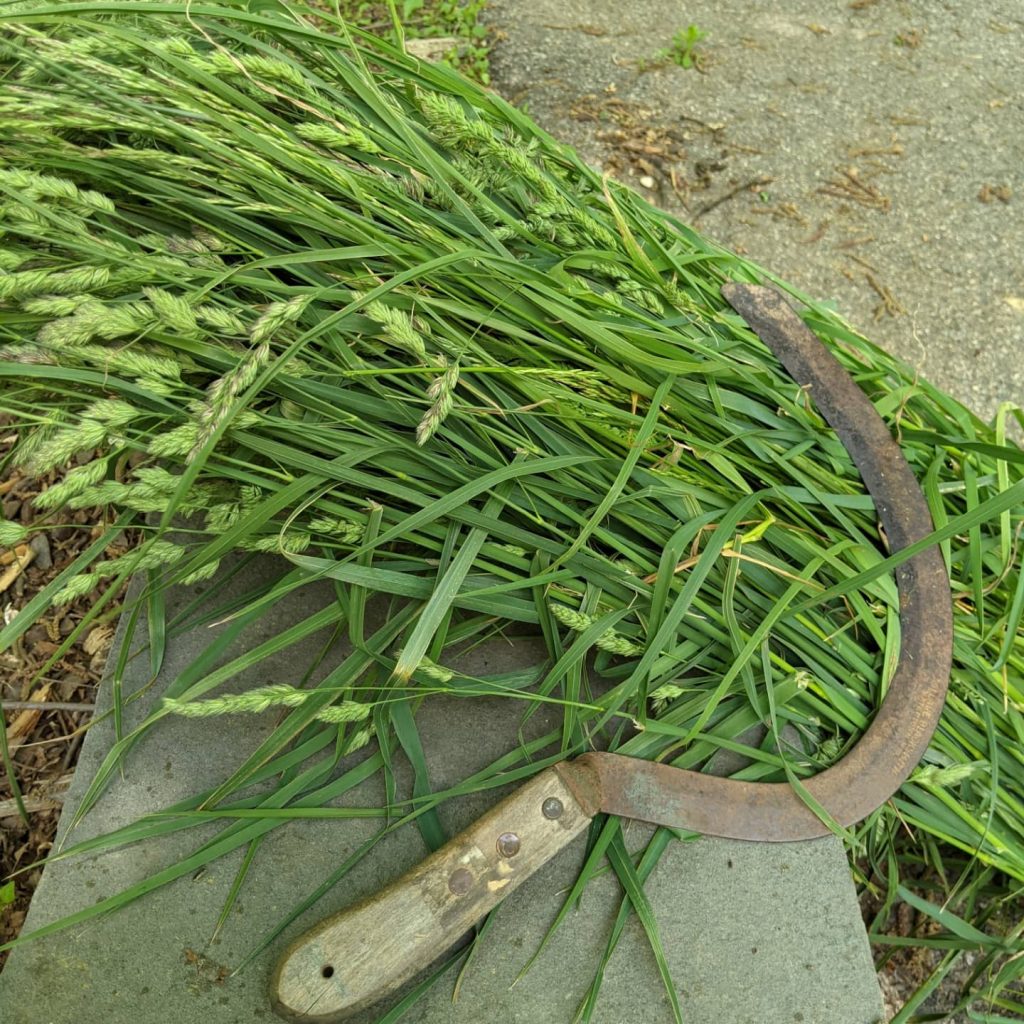
Step #2: Let it grow from lawn to pasture then mow
Ideally, we should be letting our lawn grow at least 12 inches tall before harvesting the grasses. Unfortunately, we do not have any fancy large scale haying equipment, just our trusty farmstead tractor. Five weeks and 6-10 inch long grass is about as much as it can handle. We are mowing about 2 acres of grass this way.
I have mowed small areas of 2+ foot tall grasses with my sickle and it works very well. A scythe would also work for a small section of tall grasses.
Step #3: Mow during a dry period
Water regularly falls from the sky here in Central Maryland. We rarely have a full week with no rainfall. That means it is very important to plan around the weather. One of the benefits of mowing and harvesting only 6-10 inches of grass is that it dries fairly quickly. Last week we mowed Saturday morning and harvested Monday afternoon. That is a little too close for comfort really, but it was sunny, 90 degrees, and we tedded the grass(more on this in step #4). Ideally, we would want to mow one day, ted (aerate)in the next day or two, and then rake and store the hay the following day. This week we were rushing to gather it up before a rain shower.
Step #4: Tedding to dry your grass evenly
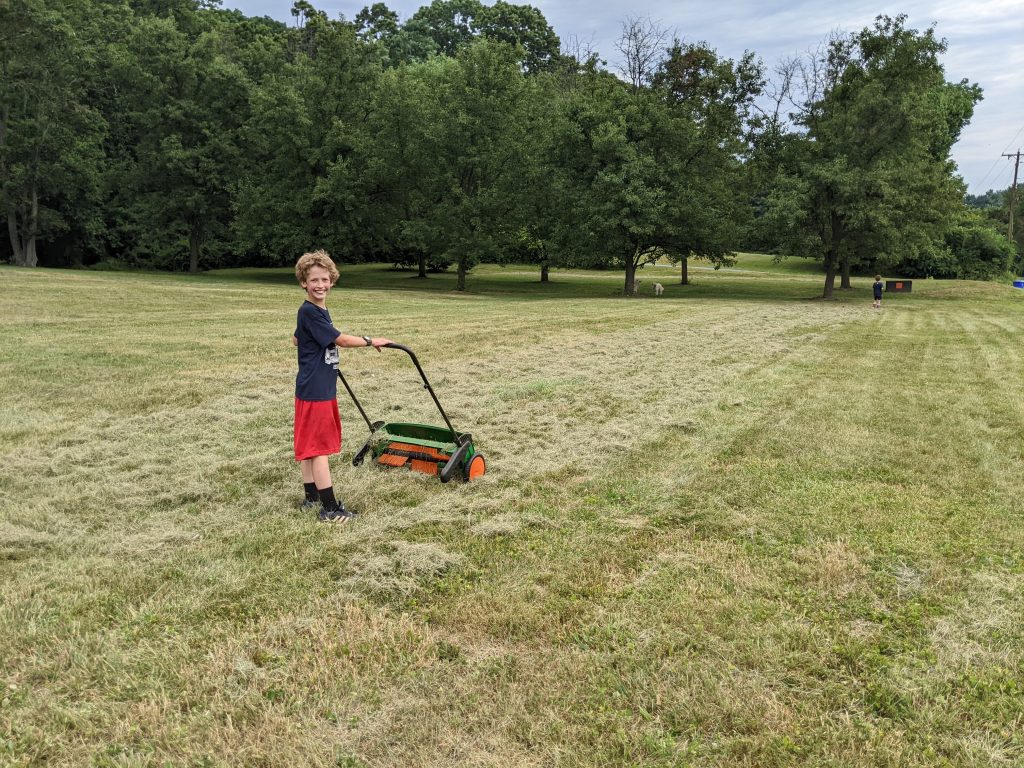
Here is where I make a shameless and totally unrecompensed plug for our newest tool. I saw one of these lawn sweepers at a thrift store and thought it might work great for small scale hay making. I did not buy it because it was missing some pieces. But I started looking into them more online and became convinced that this would be great for our homestead hay growing needs. I ordered this one from Amazon.
The sweeper lifts and turns the grass clippings. It is not nearly as fancy as a large scale tedding machine like this one from a Beef Magazine article about tedding. But for our small scale needs it works fabulously to get the grass to dry more quickly and evenly. The sweeper brushes lift and flip the grass preventing moisture from being trapped between the ground and the grass.
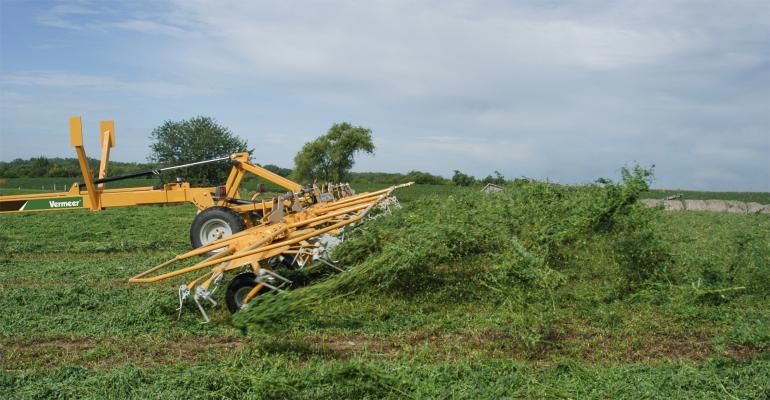
Tedding is a game changer if you are trying to get the hay in before a rain. This article from Hay and Forage explains the benefits of tedding to speed drying and get the harvest in more quickly.
Step #5: Gather the grass in breathable bundles
We also used our lawn sweeper to gather the grass. It being a novel new toy, the kids all wanted a turn driving it down the rows. With the basket attachment in place, the sweeper flings grass right into the basket.
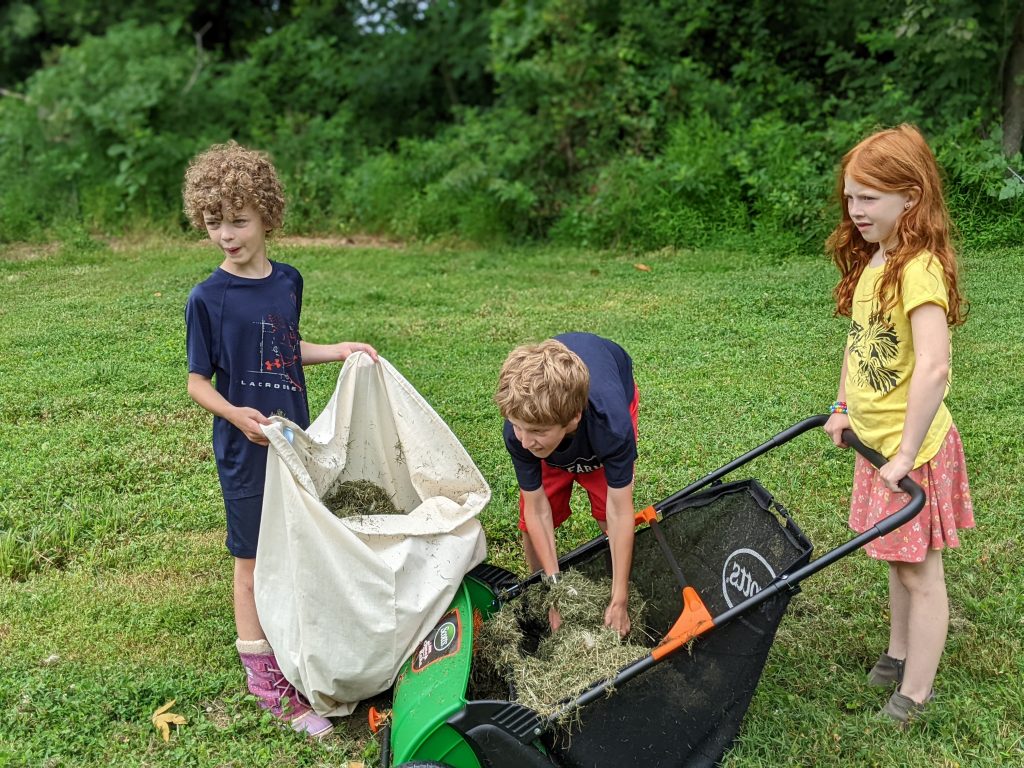
Once the bag attachment was full, we unloaded the clippings into muslin draw string bags. There are many different ways to gather and store the grass once it is dried. I just happened to have been given a big bolt of muslin by a friend. I wish that burlap was less expensive. It would have been a good breathable material for making hay bags. A friend recommended filling dollar store laundry baskets with the hay so that it could be stacked and stored in a tidy way. If you have other suggestions, please leave me a comment below. I’d love to hear your ideas.
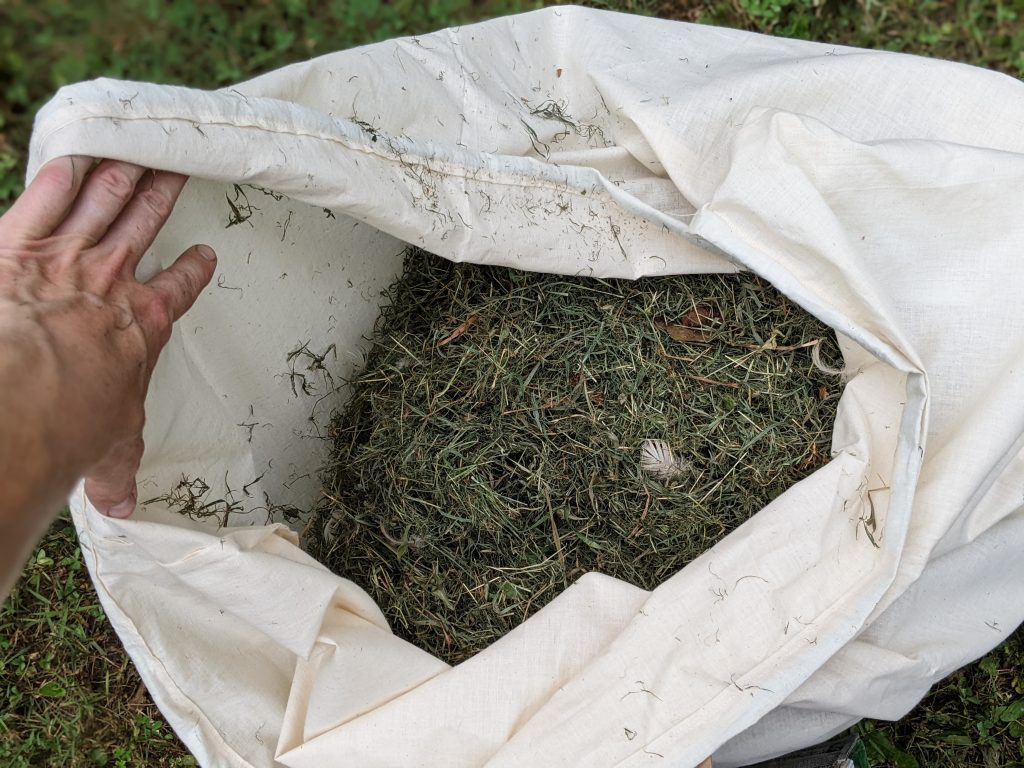
Step#6: Consider the nutritional value
According to Rabbit Production by Cheeke et al. (1987, 6th edition): If palatable greens are fed free choice, the amount of pelleted feed used can be reduced by about 50%, with no adverse effects on performance.
Rabbit Production also includes a chart on page 172 that shows the nutritional composition of various weeds and grasses. For example, our bermuda grass when dried is 7.2% protein and 26% crude fiber. Meaning our greens from the lawn while not as nutritious as alfalfa hay, are a good source of roughage and “quite palatable” for rabbits’ diet. They go on to say that the use of fresh green feed is usually only feasible on a backyard scale. That made me smile because I think we are proving that to be true. It’s a lot of work, but worthwhile on a small scale.
Due to rising feed costs we are also harvesting and feeding fresh “palatable greens” aka weeds to our rabbits every other day. Pellets are fed on the off days. Hopefully, dried “palatable greens” will also be a good source of nourishment during the winter months. So far we have 10 XL bags of dried grass & weeds in the barn loft and if all goes well we should be able to add twice that much again by the end of our growing season.
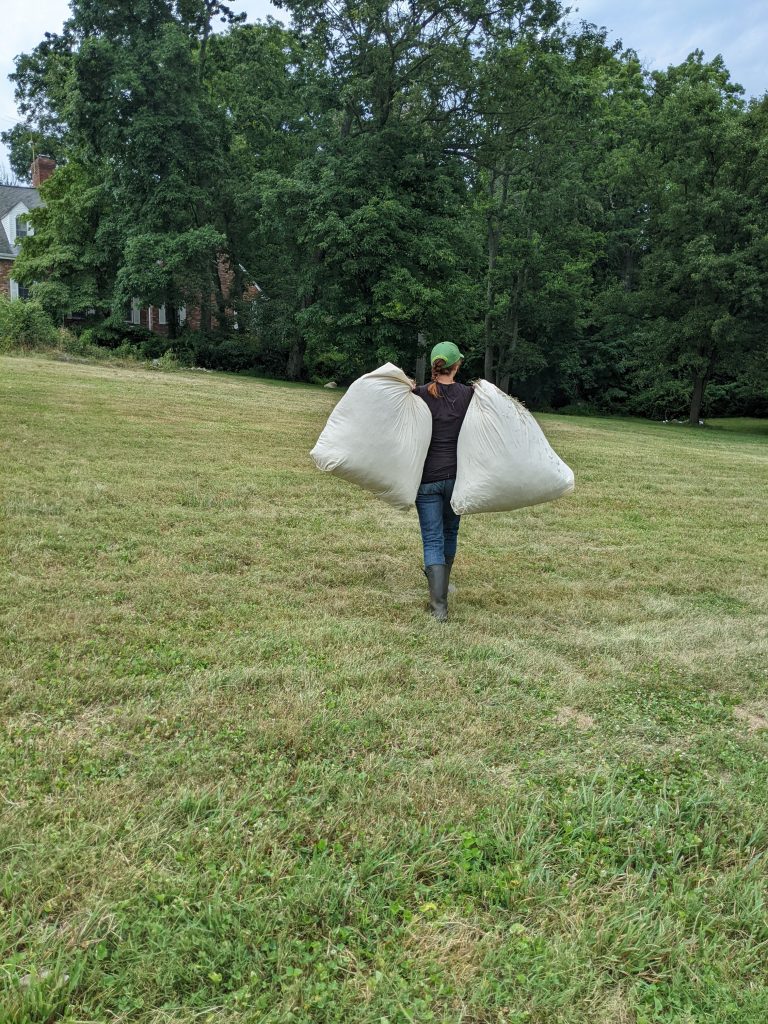




Interesring.
I also read about cardbord mulch and prepering for next year.
A tip. Using cardbord and papers is like puttning a lot of chemicals in your garden.
My husband used to work in the paperindustri in Sweden and when I was going to put cardboard in our garden he said a big NO.
And told me about al chemicals they use.
And my neighbours father has been selling print colour for pappers in all europe and I learnt from them about how bad the printcolours is today. Just a few use the more expensive and better kind.
At least over here.
I did not know that until reasently. Had just heard of the benefits from puttning it in the garden
Thank you for an interesting blog!